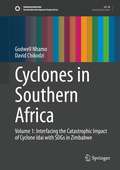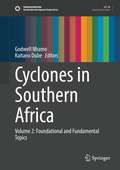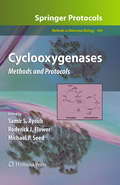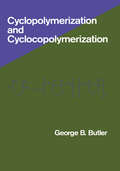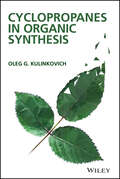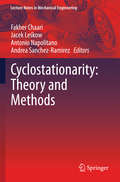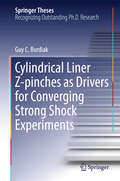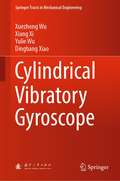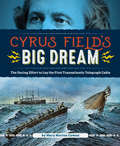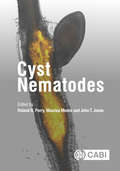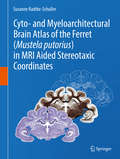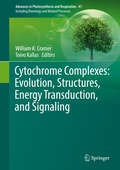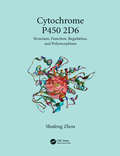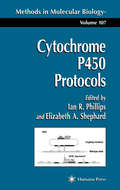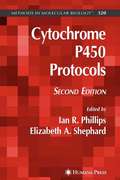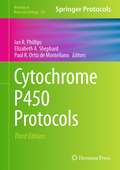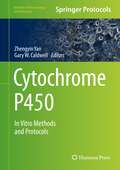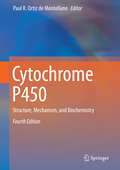- Table View
- List View
Cyclones in Southern Africa: Volume 1: Interfacing the Catastrophic Impact of Cyclone Idai with SDGs in Zimbabwe (Sustainable Development Goals Series)
by Godwell Nhamo David ChikodziThere is evidence that the world has been witnessing more intense tropical cyclones. Accompanying these tropical cyclones are heightened levels of devastation that witness the loss of human life and wildlife, destruction of natural resources and property and the disruption of major economic and social activities. To this end, there is a growing demand for publications focusing on tropical cyclones at various levels that include regional, national and local levels, especially from Africa. One sub-region that has been witnessing the harsh realities of the increasing intensity of tropical cyclones in southern Africa. However, within this region, countries are usually impacted at varying degrees of damage. Among the countries that usually encounter the harshness of these tropical cyclones are the Comoros, Botswana, Madagascar, Mauritius, Malawi, Mozambique, Reunion, the Seychelles, South Africa and Zimbabwe. From the history books, the following tropical cyclones made landfall and hit southern Africa: Eline (2000), Favio (2007), Dineo (2017), Idai (2019), Kenneth (2019), Eliose (2021), and Chalane (2020). Although all these tropical cyclones had negative impacts, it is undoubtedly Tropical Cyclone Idai that shocked the world with its devastation mainly in Mozambique, Malawi and Zimbabwe in March 2019. Key infrastructure was destroyed, livelihoods were lost, and the environment was degraded. Thousands of people died, many more were injured, many remain unaccounted for and others remained homeless as of the time of finalising this book in February 2021. This book, therefore focuses on the devastating impacts of Tropical Cyclone Idai in Zimbabwe. The book interfaces Tropical Cyclone Idai’s impacts with the 2030 Agenda for Sustainable Development and some of the 17 Sustainable Development Goals (SDGs). This linkage was deliberate given that there is still time remaining until 2030, and the world has generally agreed to move into the future along the pathways of sustainable development and sustainability. The book adds to the first comprehensive profiling of the impacts of tropical cyclones on southern African economies, particularly that of Zimbabwe. It also comes up as the first in a three-volume series. The other volumes to look out for are Cyclones in Southern Africa Vol 2: Foundational and Fundamental Topics; and Cyclones in Southern Africa Vol 3: Implications for the Sustainable Development Goals. To this end, this book is suitable as a read for several professionals and disciplines such as tourism and hospitality studies, economics, sustainable development, development studies, environmental sciences, arts, geography, life sciences, politics, planning and public health.
Cyclones in Southern Africa: Volume 2: Foundational and Fundamental Topics (Sustainable Development Goals Series)
by Godwell Nhamo Kaitano DubeThe subject of tropical cyclones in Southern Africa, also known as hurricanes or typhoons in other regions of the world, has been growing over the past few decades. However, there is still limited literature on foundational and fundamental topics on the matter. To this end, this book addresses this gap, citing some examples from both historic and recent tropical cyclones. The book presents meteorological and climatic aspects of tropical cyclones, including reviews on forecasting, warning message dissemination and public response aspects of early warning systems with a focus on the Tropical Cyclones Idai and Kenneth. Fundamentals in disaster risk reduction (DRR) are also discussed moving from the provisions of the Hyogo Framework for Action (2005–2015), to the Sendai Framework for Disaster Risk Reduction (2015–2030). Climate change issues are central to the publication, as well as the role of information and communication technologies in DRR and management. The book also tackles some challenges and opportunities associated with the implementation of regional legal and institutional frameworks on DRR. The book comes as part of a series with three volumes. The other volumes include “Cyclones in Southern Africa Vol. 1: Interfacing the Catastrophic Impact of Cyclone Idai with SDGs in Zimbabwe” and “Cyclones in Southern Africa Vol 3: Implications for the Sustainable Development Goals”. To this end, this book is suitable as a read for several professionals and disciplines such as tourism and hospitality studies, economics, sustainable development, development studies, environmental sciences, arts, geography, life sciences, politics, planning and public health.
Cyclones in Southern Africa: Volume 3: Implications for the Sustainable Development Goals (Sustainable Development Goals Series)
by Godwell Nhamo David ChikodziTropical cyclones in Southern Africa, also known as hurricanes or typhoons in other regions of the world, is a hot subject for academic research. This focus has been magnified by the need to consider tropical cyclones in the context of other global development agendas, that includes the 2030 Agenda for Sustainable Development and its inseparable 17 Sustainable Development Goals (SDGs), the Paris Agreement, the Sendai Framework for Disaster Risk Reduction and Habitat III’s New Urban Agenda. The ambitious SDGs challenge global and community leaders to make sure development addresses the nexus among poverty, inequality and employment creation, as well as care for the earth and its natural resources and biodiversity. The SDGs further present an agenda to eradicate hunger, bring quality education and sustain water and sanitation. The infrastructure development, human settlements, sustainable consumption and production, climate change, biodiversity and the ocean (blue) economy agendas are also pitched. Lastly, the 2030 Agenda for Sustainable Development encourages partnerships on delivering various programmes and projects at all spatial levels. However, as tropical cyclones continue to make multiple landfalls and ravage Southern Africa and other parts of the world, the achievement of the 2030 Agenda for Sustainable Development is threatened. To this end, this book addresses this gap by documenting the implications of tropical cyclones, drawing examples and case studies from recent tropical cyclones such as cyclone Idai and cyclone Kenneth that resulted in catastrophic impacts in 2019. The book comes as part of a series with three volumes. The other volumes include “Cyclones in Southern Africa Vol. 1: Interfacing the Catastrophic Impact of Cyclone Idai with SDGs in Zimbabwe” and “Cyclones in Southern Africa Vol 2: Foundational and Fundamental Topics”. Given the foregoing, the book is suitable as a read for several professionals and disciplines such as tourism and hospitality studies, economics, sustainable development, development studies, environmental sciences, arts, geography, life sciences, politics, planning and public health.
Cyclooxygenases: Methods and Protocols (Methods in Molecular Biology #644)
by Samir S. Ayoub Roderick J. Flower Michael SeedSince the discovery of the pharmacological and toxicological importance of inhibiting the cyclooxygenase (COX) enzymes by non-steroidal anti-inflammatory drugs (NSAIDs), much research has gone into the development of methods to study the biological functions of COX-1 and COX-2. In Cyclooxygenases: Methods and Protocols, experts and pioneers in the field present the most up-to-date in vitro and in vivo techniques routinely used in COX research. The volume delves into essential topics such as the purification, cloning, and expression of COX enzymes as well as in vitro assays aimed at determining the inhibitory potency of drugs on COX-1 and COX-2 activities, with chapters describing protocols used for the extraction and measurement of the prostanoids. This volume also describes in vivo disease models used to study the roles of COX-1 and COX-2 in gastrointestinal injury, inflammation, and pain. As a book in the highly successful Methods in Molecular BiologyTM series, the protocols chapters include brief introductions to their respective topics, lists of the necessary materials and reagents, step-by-step, readily reproducible laboratory protocols, and notes on troubleshooting and avoiding known pitfalls. Authoritative and cutting-edge, Cyclooxygenases: Methods and Protocols serves as an indispensable tool for all scientists seeking the treatment of inflammation, pain, fever, and other harmful conditions.
Cyclopolymerization and Cyclocopolymerization
by George ButlerThis broadly-based work gathers the vast bulk of information published on cyclopolymerization since its discovery - including the symmetrical diene counterparts of all classical monomers that can undergo addition polymerization, all unsymmetrical dienes, and cyclopolymerizable monomers such as dialdehydes, diynes, diisocyanates, diepoxides, dinitriles, and some organometallic monomers.;Providing access to contemporary knowledge in the field and offering discussions of interest to a wide variety of polymer scientists, Cyclopolymerization and Cyclocopolymerization: delineates theory; summarizes polymerization procedures; furnishes theoretical justification for mechanistic proposals; details commercial applications; and describes new monomer syntheses. Supplying over 2700 references as well as chemical abstract citations, Cyclopolymerization and Cyclocopolymerization is a resource which should be of practical value to polymer, academic, theoretical and industrial chemists; chemical and plastics engineers; research and development directors in chemistry and chemical engineering programmes; and graduate-level students in these disciplines
Cyclopropanes in Organic Synthesis
by Oleg G. KulinkovichThis is a practical guidebook about cyclopropanes that thoroughly surveys derivatives and transformations, synthetic methods, and experimental efficiency as a gateway for further research and development in the field.* Provides comprehensive lists and synthetically-oriented synopses of cyclopropane chemistry review references along with publication data on applications in the syntheses of natural and related biologically active compounds* Acts as a resource to help readers better understand cyclopropane applications for the efficient realization of synthetically important organic transformations and popular experimental procedures* Includes new developments and up-to-date information that will lead to original methodologies for complex organic synthesis* Stresses universality, flexibility, and experimental efficiency of a strategy based on preparing cyclopropane derivatives and performing ring cleavage reactions with inexpensive reagents* Focuses on the synthetic potential of cyclopropane applications, for example the synthesis of natural compounds and other target-oriented syntheses via cyclopropane intermediaries, as well on their planning by retrosynthetic analysis
Cyclospora cayetanensis as a Foodborne Pathogen (SpringerBriefs in Food, Health, and Nutrition)
by Lucy J. Robertson Ynés R. OrtegaThis Brief provides a comprehensive overview of Cyclospora cayetanensis, a protozoan apicomplexan parasite that leads to outbreaks of traveler's diarrhea in consumers. The main characteristics of Cyclospora cayetanensis infection are covered, including documented outbreaks, regional patterns and statistics. Various transmission routes for this parasite are outlined, with a focus on foodborne transmission. A major focus of Cyclospora Cayetanensis As A Foodborne Pathogen is the detection of Cyclospora cayetanensis in different food matrices. Decontamination procedures for the occurrence of this parasite in all major food types are outlined in detail, as well as current risk assessment procedures and regulations. The difficulty in minimizing the risk of infection in fresh produce is covered, plus potential solutions for this problem. This Brief not only comprehensively covers the current state of foodborne Cyclospora cayetanensis but also looks to future challenges in the detection, prevention and removal of this parasite in foods.
Cyclostationarity: Theory And Methods (Lecture Notes in Mechanical Engineering #3)
by Antonio Napolitano Fakher Chaari Jacek Leśkow Andrea Sanchez-RamirezIn the last decade the research in signal analysis was dominated by models that encompass nonstationarity as an important feature. This book presents the results of a workshop held in Grodek--Poland in February 2013 which was dedicated to the investigation of cyclostationary signals. Its main objective is to highlight the strong interactions between theory and applications of cyclostationary signals with the use of modern statistical tools. An important application of cyclostationary signals is the analysis of mechanical signals generated by a vibrating mechanism. Cyclostationary models are very important to perform basic operations on signals in both time and frequency domains. One of the fundamental problems in diagnosis of rotating machine is the identification of significant modulating frequencies that contribute to the cyclostationary nature of the signals. The book shows that there are modern tools available for analyzing cyclostationary signals without the assumption of gaussianity. Those methods are based on the ideas of bootstrap, subsampling and Fraction-of-time (FOT) models. The book is organised in two parts. The first part will be dedicated to pure theory on cyclostationarity. Applications are presented in the second part including several mechanical systems such as bearings, gears, with or without damages.
Cylindrical Liner Z-pinches as Drivers for Converging Strong Shock Experiments (Springer Theses)
by Guy C. BurdiakThe thesis represents the development of an entirely new experimental platform for generating and studying converging radiative shock waves. It was discovered that the application of large magnetic pressures to gas-filled cylindrical metallic tubes could sequentially produce three shocks within the gas. A comprehensive set of instrumentation was devised to explore this system in detail and an exceptionally thorough experimental and theoretical study was carried out in order to understand the source of the shock waves and their dynamics. The research is directed towards some of the most interesting topics in high energy density physics (HEDP) today, namely the interaction of HED material with radiation and magnetic fields, with broad applications to inertial confinement fusion (ICF) and laboratory plasma astrophysics. The work has already generated significant international interest in these two distinct research areas and the results could have significant importance for magnetic ICF concepts being explored at Sandia National Laboratories in the US and for our understanding of the very strong shock waves that are ubiquitous in astrophysics.
Cylindrical Vibratory Gyroscope (Springer Tracts in Mechanical Engineering)
by Xuezhong Wu Xiang Xi Yulie Wu Dingbang XiaoThis book introduces readers to the shell structure, operating principle, manufacturing process, and control theory for cylindrical vibratory gyroscopes. The cylindrical vibratory gyroscope is an important type of Coriolis vibratory gyroscope that holds considerable potential for development and application. The main aspects addressed include: operating principle and structure, theoretical analysis and modeling, dynamic analysis and modeling, manufacturing process, parameter testing methods, closed-loop control, and the error compensation mechanism in cylindrical vibratory gyroscopes.
Cyrus Field's Big Dream: The Daring Effort to Lay the First Transatlantic Telegraph Cable
by Mary Morton CowanIn this middle-grade nonfiction title, award-winning author Mary Morton Cowan explores the extraordinary achievement of Cyrus Field and one of the greatest engineering feats of the nineteenth century: laying a transatlantic telegraph cable to create instant communication between two continents. <P><P> Cyrus Field had a big dream to connect North America and Europe with a telegraph line, which would enable instant communication. In the mid-1800s, no one knew if it was possible. That didn’t dissuade Field, who set out to learn about undersea cables and build a network of influential people to raise money and create interest in his project. Field experienced numerous setbacks: many years of delays and failed attempts, millions of dollars lost, suspected sabotage, technological problems, and more. But Field did not give up, ultimately realizing his dream in the summer of 1866. <P><P>Mary Morton Cowan brilliantly captures Field’s life and his steadfast determination to achieve his dream. Back matter includes an author’s note, timeline, bibliography, source notes, and index.
Cyst Nematodes
by Maurice Moens Roland N. Perry Victoria Taylor John T. Jones Godelieve Gheysen Jon Pickup Matthew A. Back James G. Baldwin George W. Bird Vivian C. Blok David J. Chitwood Laura Cortada Matthias Daub Keith G. Davies Walter S. Jong Loes J.M.F. Nijs Sebastian Eves-van Akker Aska Goverse Ivan G. Grove Professor Johannes Hallmann Zafar A. Handoo Catherine J. Lilley Horacio D. Lopez-Nicora Edward P. Masler Melissa G. Mitchum Sharad Mohan Terry L. Niblack Adrian M.I. Roberts Andrea M. Skantar Geert Smant Richard W. Smiley Sergei A Subbotin Gregory L. Tylka Lieven Waeyenberge Inga A. ZasadaThis book is a compendium of current information on all aspects of these economically important parasites. It provides comprehensive coverage of their biology, management, morphology and diagnostics, in addition to up-to-date information on molecular aspects of taxonomy, host-parasitic relationships and resistance. Written by a team of international experts, Cyst Nematodes will be invaluable to all researchers, lecturers and students in nematology, parasitology, agriculture and agronomy, industries with an interest in chemical and biological control products for management of plant-parasitic nematodes, and any courses, quarantine and advisory services.
Cystic Fibrosis: Diagnosis and Protocols, Volume I: Approaches to Study and Correct CFTR Defects (Methods in Molecular Biology #741)
by Karl Kunzelmann Margarida D. AmaralDespite the many milestones in cystic fibrosis (CF) research, progress towards curing the disease has been slow, and it is increasingly difficult to grasp and use the already wide and still growing range of diverse methods currently employed to study CF so as to understand it in its multidisciplinary nature. Cystic Fibrosis: Diagnosis and Protocols aims to provide the CF research community and related researchers with a very wide range of high-quality experimental tools, as an easy way to grasp and use classical and novel methods applied to cystic fibrosis. Volume I: Approaches to Study and Correct CFTR Defects focuses on the cystic fibrosis transmembrane conductance regulator (CFTR) and its expression, biogenesis, structure, and function in terms of the defects causing CF. Written in the highly successful Methods in Molecular BiologyTM series format, chapters include introductions to their respective topics, lists of the necessary materials and reagents, step-by-step, readily reproducible laboratory protocols, and tips on troubleshooting and avoiding known pitfalls. Comprehensive and practical, Cystic Fibrosis: Diagnosis and Protocols will provide readers with optimal working tools to address pressing questions in the best technical way, while helping all of us, as a research and clinical community, to move faster hand-in-hand toward unravelling the secrets of this challenging disorder and cure it.
Cystic Fibrosis: Diagnosis and Protocols, Volume II: Methods and Resources to Understand Cystic Fibrosis (Methods in Molecular Biology #742)
by Karl Kunzelmann Margarida D. AmaralDespite the many milestones in cystic fibrosis (CF) research, progress toward curing the disease has been slow, and it is increasingly difficult to grasp and use the already wide and still growing range of diverse methods currently employed to study CF so as to understand it in its multidisciplinary nature. Cystic Fibrosis: Diagnosis and Protocols aims to provide the CF research community and related researchers with a very wide range of high-quality experimental tools, as an easy way to grasp and use classical and novel methods applied to cystic fibrosis. Volume II: Methods and Resources to Understand Cystic Fibrosis focuses on pathophysiology, Omics approaches, and a variety of key resources recently made available for CF research. Written in the highly successful Methods in Molecular BiologyTM series format, chapters include introductions to their respective topics, lists of the necessary materials and reagents, step-by-step, readily reproducible laboratory protocols, and tips on troubleshooting and avoiding known pitfalls. Comprehensive and practical, Cystic Fibrosis: Diagnosis and Protocols will provide readers with optimal working tools to address pressing questions in the best technical way, while helping all of us, as a research and clinical community, to move faster hand-in-hand toward unravelling the secrets of this challenging disorder and cure it.
Cyto- and Myeloarchitectural Brain Atlas of the Ferret (Mustela putorius) in MRI Aided Stereotaxic Coordinates
by Susanne Radtke-SchullerDescriptionThis stereotaxic atlas of the ferret brain provides detailed architectonic subdivisions of the cortical and subcortical areas in the ferret brain using high-quality histological material stained for cells and myelin together with in vivo magnetic resonance (MR) images of the same animal. The skull-related position of the ferret brain was established according to in vivo MRI and additional CT measurements of the skull. Functional denotations from published physiology and connectivity studies are mapped onto the atlas sections and onto the brain surface, together with the architectonic subdivisions. High-resolution MR images are provided at levels of the corresponding histology atlas plates with labels of the respective brain structures. The book is the first atlas of the ferret brain and the most detailed brain atlas of a carnivore available to date. It provides a common reference base to collect and compare data from any kind of research in the ferret brain.Key Features Provides the first ferret brain atlas with detailed delineations of cortical and subcortical areas in frontal plane. Provides the most detailed brain atlas of a carnivore to date. Presents a stereotaxic atlas coordinate system derived from high-quality histological material and in vivo magnetic resonance (MR) images of the same animal. Covers the ferret brain from forebrain to spinal cord at intervals of 0.6 mm on 58 anterior-posterior levels with 5 plates each. Presents cell (Nissl) stained frontal sections (plate 1) and myelin stained sections (plate 2) in a stereotaxic frame. Provides detailed delineations of brain structures and their denomination on a Nissl stained background on a separate plate (3). Compiles abbreviations on plate 4, a plate that also displays the low resolution MRI of the atlas brain with the outlines of the Nissl sections in overlay. Displays high-resolution MR images at intervals of 0.15 mm from another animal with labeled brain structures as plate 5 corresponding to the anterior-posterior level of each atlas plate. Provides detailed references used for delineation of brain areas. Target audience of the book: The book addresses researchers and students in neurosciences who are interested in brain anatomy in general (e.g., for translational purposes/comparative aspects), particularly those who study the ferret as important animal model of growing interest in neurosciences.
Cytochrome Complexes: Evolution, Structures, Energy Transduction, and Signaling (Advances in Photosynthesis and Respiration #41)
by William A. Cramer Toivo KallasAn Introduction that describes the origin of cytochrome notation also connects to the history of the field, focusing on research in England in the pre-World War II era. The start of the modern era of studies on structure-function of cytochromes and energy-transducing membrane proteins was marked by the 1988 Nobel Prize in Chemistry, given to J. Deisenhofer, H. Michel, and R. Huber for determination of the crystal structure of the bacterial photosynthetic reaction center. An ab initio logic of presentation in the book discusses the evolution of cytochromes and hemes, followed by theoretical perspectives on electron transfer in proteins and specifically in cytochromes. There is an extensive description of the molecular structures of cytochromes and cytochrome complexes from eukaryotic and prokaryotic sources, bacterial, plant and animal. The presentation of atomic structure information has a major role in these discussions, and makes an important contribution to the broad field of membrane protein structure-function.
Cytochrome P450 2D6: Structure, Function, Regulation and Polymorphism
by Shufeng ZhouCytochromes are proteins that catalyze electron transfer reactions of well-known metabolic pathways and are classified in various superfamilies. The CYP, or P450, superfamily accounts for 90% of the oxidative metabolism of clinical drugs. One member of this superfamily, P450 2D6 (or CYP2D6), singlehandedly metabolizes about 25% of all medications in the human liver. Cytochrome P450 2D6: Structure, Function, Regulation, and Polymorphism reviews the current knowledge of CYP2D6 as well as the maturing body of evidence indicating its significance to clinical and pharmacological researchers and practitioners. This book focuses on the critical role CYP2D6 plays in the human liver. It examines the genetic, epigenetic, physiological, pathological, and structural factors of the gene that govern the highly variable metabolism of a number of drugs in clinical use. It highlights the impact of the functional roles of CYP2D6 on clinical practice and drug development and also discusses implications for precise medicine, strategies to avoid adverse drug reactions, and paths for future research. Cytochrome P450 2D6 is a unique, valuable book focusing on a single but immensely powerful human gene. It provides the first single source of comprehensive information on CYP2D6 that serves as an important reference for medical, biomedical, pharmaceutical, and nursing researchers, practitioners, and students.
Cytochrome P450 2E1: Its Role In Disease And Drug Metabolism (Subcellular Biochemistry #67)
by Aparajita DeyThe book deals with various clinical aspects of cytochrome P450 2E1 (CYP2E1) which is a potent source for oxidative stress. Oxidative stress is critical for pathogenesis of diseases and CYP2E1 is a major contributor for oxidative stress. Several clinical disorders are associated with changes in regulation of CYP2E1 and the consequent abnormalities which include alcoholic liver disease, alcoholic pancreatitis, carcinogenesis, non-alcoholic fatty liver disease, non-alcoholic steatohepatitis, obesity, hepatitis C virus infection, reproductive organ toxicity, hepatocellular and cholestatic liver cirrhosis, inhibition of bone repair, cross-tolerance in smokers and people treated with nicotine, disorders of central nervous system, changes in metabolism of protoxicants in the circulatory system and susceptibility to human papillomavirus infection. Hence, CYP2E1 emerges as a new and potent player in aggravating injury and furthering disease complications.
Cytochrome P450 Protocols (Methods in Molecular Biology #107)
by Elizabeth A. Shephard Ian R. PhillipsIan Phillips and Elizabeth Shephard assemble a comprehensive collection of cutting-edge techniques and invaluable classic methods for the investigation of cytochromes P450. Described in detail by hands-on experimentalists for easy reproducibility, these methods include spectral analysis, purification and enzymatic assays, expression in heterologous systems, and the production and use of antibodies, as well as methods for quantification of gene expression, transfection of hepatocytes, and for the investigation of DNA-protein interactions and genetic polymorphism. In addition, because of the growing importance of in vitro systems in pharmacological toxicology, the book contains techniques for the culture of rodent and human hepatocytes and human epidermis. Cytochrome P450 induction as a biomarker for environmental pollution and the generation of mice with targeted gene disruptions complete this exhaustive collection of core techniques. Cytochrome P450 Protocols provides both novice and experienced researchers across many fields-toxicology, pharmacology, environmental biology, biochemistry, and molecular biology-all the tools needed to elucidate the crucial biological role played by the cytochromes P450 in the metabolism of therapeutic drugs, chemical carcinogens, and environmental pollutants.
Cytochrome P450 Protocols (Methods in Molecular Biology #320)
by Ian R. PhillipsFor this second edition of their much praised Cytochrome P450, the editors have collected accounts of the essential core techniques that use the latest methodologies for the investigation of P450s. Highlights include protocols for spectral analysis and purification of P450s, enzymatic assays of P450s and flavin-containing monooxygenases (FMOs), expression of P450s and FMOs in heterologous systems, and the production and use of antipeptide antibodies. Additional chapters contain readily reproducible techniques for the transfection of hepatocytes for gene regulation studies, P450 reporter gene assays, in situ hybridization, and analysis of genetic polymorphisms. Although the emphasis is on P450s of mammalian origin, many of the readily reproducible methods described are suitable for P450s from any source.
Cytochrome P450 Protocols (Methods in Molecular Biology #987)
by Elizabeth A. Shephard Ian R. Phillips Paul R. Ortiz de MontellanoCytochromes P450 (CYPs) comprise a large superfamily of proteins that are of central importance in the detoxification or activation of a tremendous number of natural and synthetic hydrophobic xenobiotics, including many therapeutic drugs, chemical carcinogens and environmental pollutants. CYPs are important in mediating interactions between an organism and its chemical environment and in the regulation of physiological processes. Cytochrome P450 Protocols, Third Edition focuses on high-throughput methods for the simultaneous analysis of multiple CYPs, substrates or ligands. Although the emphasis is on CYPs of mammalian origin, it reflects an increasing interest in CYPs of bacterial species. Also included are chapters on cytochrome P450 reductase (the redox partner of CYPs) and the flavin-containing monooxygenases (FMOs), and metabolomic and lipidomic approaches for identification of endogenous substrates of CYPs ('de-orphanizing' CYP substrates). Written in the successful Methods in Molecular BiologyTM series format, chapters include introductions to their respective topics, lists of the necessary materials and reagents, step-by-step, readily reproducible protocols, and notes on troubleshooting and avoiding known pitfalls. Authoritative and easily accessible, Cytochrome P450 Protocols, Third Edition provides a wide range of techniques accessible to researchers in fields as diverse as biochemistry, molecular biology, pharmacology, toxicology, environmental biology and genetics.
Cytochrome P450: In Vitro Methods and Protocols (Methods in Pharmacology and Toxicology)
by Gary W. Caldwell Zhengyin YanThis collection explores detailed experimental protocols necessary for setting up a variety of in vitro cytochrome P450 (CYP) assays that are vital in selecting drug candidates in a drug discovery pipeline. Major factors affecting drug metabolism include CYP expression levels, kinetic parameters for individual CYP enzymes, CYP inhibition and induction, time-dependent inhibition (TDI), CYP stability, non-CYP stability, UDP-glucuronosyltransferases (UGT) stability, excretion mechanisms, and drug-drug interactions (DDI), all addressed in this volume. Written for the Methods in Pharmacology and Toxicology series, chapters include helpful background information on the in vitro assay, a list of all the materials, reagents, and equipment necessary to carry out the assay, a step-by-step protocol, notes containing common and unexpected experimental problems in the assay, as well as references containing important supplementary reading. Authoritative and practical, Cytochrome P450: In Vitro Methods and Protocols serves as a key guide for researchers in the area of discovery and development of new medicines.
Cytochrome P450: Structure, Mechanism, and Biochemistry (Methods in Molecular Biology #987)
by Paul R. Ortiz de MontellanoThis authoritative Fourth Edition summarizes the advances of the past decade concerning the structure, mechanism, and biochemistry of cytochrome P450 enzymes, with sufficient coverage of earlier work to make each chapter a comprehensive review of the field. Thirteen chapters are divided into two detailed volumes, the first covering the fundamentals of cytochrome P450 biochemistry, as well as the microbial, plant, and insect systems, and the second exclusively focusing on mammalian systems. Volume 1 begins with an exploration of the biophysics and mechanistic enzymology of cytochrome P450 enzymes, with a discussion of the structures of P450 enzymes and their electron donor partners, the mechanisms of oxygen activation and substrate oxidation, and the approaches and nature of cytochrome P450 inhibition. Two more chapters discuss the nature and roles of cytochrome P450 enzymes in microbes, plants and insects, and an eighth chapter is a survey of the potential utility of P450 enzymes in biotechnology. The first chapter of Volume 2 examines the roles of P450 enzymes in mammals, mainly humans. Four further chapters then deal with the genetic and hormonal regulation of P450 enzymes and their specific roles in the processing of sterols and lipids. Cytochrome P450: Structure, Mechanism, and Biochemistry is a key resource for scientists, professors, and students interested in fields as diverse as biochemistry, chemistry, biophysics, molecular biology, pharmacology and toxicology.
Cytogenetic Abnormalities
by S. ZneimerThis guide discusses chromosomal abnormalities and how best to report and communicate lab findings in research and clinical settings. Providing a standard approach to writing cytogenetic laboratory reports, the guide further covers useful guidance on implementing International System for Human Cytogenetic Nomenclature in reports. Part one of the guide explores chromosomal, FISH, and microarray analysis in constitutional cytogenetic analyses, while part two looks at acquired abnormalities in cancers. Both sections provide illustrative examples of chromosomal abnormalities and how to communicate these findings in standardized laboratory reports.
Cytogenetic Laboratory Management: Chromosomal, FISH and Microarray-Based Best Practices and Procedures
by Susan Mahler ZneimerCytogenetic Laboratory Management: Chromosomal, FISH and Microarray-Based Best Practices and Procedures is a practical guide that describes how to develop and implement best practice processes and procedures in the genetic laboratory setting. The text first describes good laboratory practices, including quality management, design control of tests and FDA guidelines for laboratory developed tests, and pre-clinical validation study designs. The second focus of the book describes best practices for staffing and training, including cost of testing, staffing requirements, process improvement using Six Sigma techniques, training and competency guidelines and complete training programs for cytogenetic and molecular genetic technologists. The third part of the text provides step-wise standard operating procedures for chromosomal, FISH and microarray-based tests, including pre-analytic, analytic and post-analytic steps in testing, and divided into categories by specimen type, and test-type. All three sections of the book include example worksheets, procedures, and other illustrative examples that can be downloaded from the Wiley website to be used directly without having to develop prototypes in your laboratory. Providing both a wealth of information on laboratory management and molecular and cytogenetic testing, Cytogenetic Laboratory Management will be an essential tool for laboratorians world-wide in the field of laboratory testing and genetics testing in particular. This book gives the essentials of: Developing and implementing good quality management programs in laboratories Understanding design control of tests and pre-clinical validations studies and reports FDA guidelines for laboratory developed tests Use of reagents, instruments and equipment Cost of testing assessment and process improvement using Six Sigma methodology Staffing training and competency objectives Complete training programs for molecular and cytogenetic technologists Standard operating procedures for all components of chromosomal analysis, FISH and microarray testing of different specimen types This volume is a companion to Cytogenetic Abnormalities: Chromosomal, FISH and Microarray-Based Clinical Reporting. The combined volumes give an expansive approach to performing, reporting and interpreting cytogenetic laboratory testing and the necessary management practices, staff and testing requirements.
